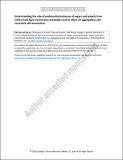| dc.contributor.author | Sudrik, Chaitanya M | |
| dc.contributor.author | Cloutier, Theresa | |
| dc.contributor.author | Mody, Neil | |
| dc.contributor.author | Sathish, Hasige A | |
| dc.contributor.author | Trout, Bernhardt L | |
| dc.date.accessioned | 2021-09-20T17:17:23Z | |
| dc.date.available | 2021-09-20T17:17:23Z | |
| dc.date.issued | 2019-05-24 | |
| dc.identifier.uri | https://hdl.handle.net/1721.1/131512 | |
| dc.description.abstract | Abstract
Purpose
To investigate differences in the preferential exclusion of trehalose, sucrose, sorbitol and mannitol from the surface of three IgG1 monoclonal antibodies (mAbs) and understand its effect on the aggregation and reversible self-association of mAbs at high-concentrations.
Methods
Preferential exclusion was measured using vapor pressure osmometry. Effect of excipient addition on accelerated aggregation kinetics was quantified using size exclusion chromatography and on reversible self-association was quantified using dynamic light scattering.
Results
The doubling of excipient concentration in the 0 to 0.5 m range resulted in a doubling of the mAb transfer free energy for all excipients and antibodies tested in this study. Solution pH and choice of buffering agent did not significantly affect the magnitude of preferential exclusion. We find that aggregation suppression for trehalose, sucrose and sorbitol (but not mannitol) correlates with the magnitude of their preferential exclusion from the native state of the three IgG1 mAbs. We also find that addition of sugars and polyols reduced the tendency for reversible self-association in two mAbs that had weakly repulsive or neutral self-interactions in the presence of buffer alone.
Conclusions
The magnitude of preferential exclusion for trehalose, sucrose and sorbitol correlates well with their partial molar volumes in solution. Mannitol is excluded to a greater extent than that expected from its partial molar volume, suggesting specific interactions of mannitol that might be different than the other sugars and polyols tested in this study. Local interactions play a role in the effect of excipient addition on the reversible self-association of mAbs. These results provide further insights into the stabilization of high-concentration mAb formulations by sugars and polyols. | en_US |
| dc.publisher | Springer US | en_US |
| dc.relation.isversionof | https://doi.org/10.1007/s11095-019-2642-3 | en_US |
| dc.rights | Creative Commons Attribution-Noncommercial-Share Alike | en_US |
| dc.rights.uri | http://creativecommons.org/licenses/by-nc-sa/4.0/ | en_US |
| dc.source | Springer US | en_US |
| dc.title | Understanding the Role of Preferential Exclusion of Sugars and Polyols from Native State IgG1 Monoclonal Antibodies and its Effect on Aggregation and Reversible Self-Association | en_US |
| dc.type | Article | en_US |
| dc.identifier.citation | Pharmaceutical Research. 2019 May 24;36(8):109 | en_US |
| dc.contributor.department | Massachusetts Institute of Technology. Department of Chemical Engineering | |
| dc.eprint.version | Author's final manuscript | en_US |
| dc.type.uri | http://purl.org/eprint/type/JournalArticle | en_US |
| eprint.status | http://purl.org/eprint/status/PeerReviewed | en_US |
| dc.date.updated | 2020-09-24T21:30:40Z | |
| dc.language.rfc3066 | en | |
| dc.rights.holder | Springer Science+Business Media, LLC, part of Springer Nature | |
| dspace.embargo.terms | Y | |
| dspace.date.submission | 2020-09-24T21:30:40Z | |
| mit.license | OPEN_ACCESS_POLICY | |
| mit.metadata.status | Authority Work and Publication Information Needed | |
